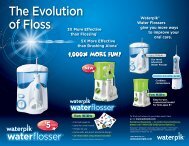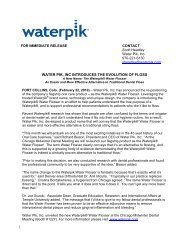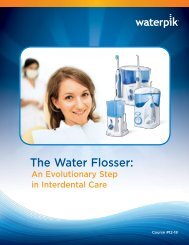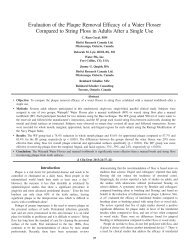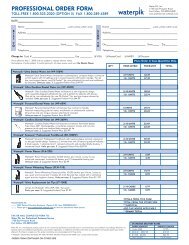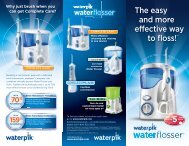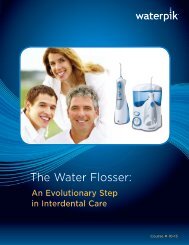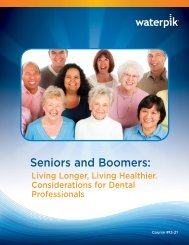Addition of Water Flosser to Power Tooth Brushing: Effect ... - Waterpik
Addition of Water Flosser to Power Tooth Brushing: Effect ... - Waterpik
Addition of Water Flosser to Power Tooth Brushing: Effect ... - Waterpik
Create successful ePaper yourself
Turn your PDF publications into a flip-book with our unique Google optimized e-Paper software.
58 The Journal <strong>of</strong> Clinical Dentistry Vol. XXIII, No. 2<br />
indices. 11-18 A study by Sharma, et al. 11 showed the addition <strong>of</strong><br />
a water flosser <strong>to</strong> manual brushing reduced gingivitis scores by<br />
41.2% over four weeks. The pulsating action <strong>of</strong> a water flosser<br />
creates a compression and decompression phase <strong>of</strong> the gingival<br />
tissue, allowing for the water or other solution <strong>to</strong> reach the subgingival<br />
and interdental areas around the <strong>to</strong>oth, effectively removing<br />
plaque, bacteria, and debris. 19-21 These areas are generally<br />
inaccessible by <strong>to</strong>oth brushing. The action <strong>of</strong> a sonic<br />
<strong>to</strong>othbrush creates sonic energy and fluid movement, but it is not<br />
equivalent <strong>to</strong> the hydrodynamic action <strong>of</strong> a water flosser. This<br />
study evaluates the regimen <strong>of</strong> power <strong>to</strong>oth brushing plus a water<br />
flosser <strong>to</strong> power <strong>to</strong>oth brushing alone on improving the oral<br />
health parameters <strong>of</strong> bleeding, gingivitis, and plaque.<br />
Materials and Methods<br />
Subjects<br />
One-hundred and forty healthy, non-smoking male and female<br />
adults between the ages <strong>of</strong> 25 and 65 years (Table I) were<br />
enrolled in this study. Subjects had a minimum <strong>of</strong> 1.75 for their<br />
Modified Gingival Index (MGI), 50% bleeding on probing<br />
(BOP), and ≥ 0.60 for a Rus<strong>to</strong>gi Modified Navy Plaque Index<br />
(RMNPI) score at baseline. Subjects had at least 20 scoreable<br />
teeth, not including third molars, and no hard or s<strong>of</strong>t tissue lesions.<br />
Recruits were excluded from the study if they had visible<br />
signs <strong>of</strong> advanced periodontal disease, probing depth > 5 mm,<br />
any systemic disease such as diabetes or au<strong>to</strong>immune disease,<br />
pregnant at the time <strong>of</strong> the study, medication use that could impact<br />
gingival health, or use <strong>of</strong> antibiotics within six months <strong>of</strong> the<br />
study. Subjects with orthodontic appliances, implants, crowns,<br />
bridges, veneers, or removable appliances were not included. The<br />
study pro<strong>to</strong>col and case report forms (CRF) were approved by the<br />
institutional review board (Institutional BRCL). Subjects completed<br />
a medical his<strong>to</strong>ry and read and signed an approved consent<br />
form.<br />
Table I<br />
Demographic Data<br />
WFS (G1) SP (G2) SF (G3) MT (G4) Overall<br />
(N = 35) (N = 35) (N = 35) (N = 35) (N = 140)<br />
Age (years)<br />
Mean 44.3 41.5 43.5 43.1 43.1<br />
SD 10.60 07.51 8.61 8.22 8.78<br />
SEM 1.79 1.27 1.46 1.39 0.74<br />
Minimum 26 28 25 25 25.<br />
Maximum 64 56 59 56. 64<br />
Gender<br />
Male 15 (42.9%) 11 (31.4%) 8 (22.9%) 10 (28.6%) 44 (31.4%)<br />
Female 20 (57.1%) 24 (68.6%) 27 (77.1%) 25 (71.4%) 96 (68.6%)<br />
Smoke<br />
No 35 (100%) 35 (100%) 35 (100%) 35 (100%) 140 (100%)<br />
SD = Standard Deviation, SEM = Standard Error <strong>of</strong> the Mean.<br />
p-value for age (p = 0.883) from a Wilcoxon Rank-Sum test.<br />
p-value for gender (p = 0.367) from a Fisher’s Exact test.<br />
Study Devices<br />
The <strong>Water</strong>pik ® Complete Care (WFS; Model WP-900, <strong>Water</strong><br />
Pik, Inc., Fort Collins, CO, USA) is a power-driven device that<br />
combines two products in<strong>to</strong> one; the <strong>Water</strong>pik ® <strong>Water</strong> <strong>Flosser</strong><br />
and the <strong>Water</strong>pik ® Sensonic ® Pr<strong>of</strong>essional Plus <strong>Tooth</strong>brush. The<br />
water flosser works through the combination <strong>of</strong> pressure and pulsation<br />
that provides a pulsating stream <strong>of</strong> water that can access<br />
the interdental, marginal, and subgingival areas around the <strong>to</strong>oth.<br />
The <strong>Water</strong>pik Sensonic Pr<strong>of</strong>essional Plus <strong>Tooth</strong>brush utilizes<br />
sonic technology <strong>to</strong> generate brushing strokes <strong>to</strong> clean the <strong>to</strong>oth<br />
surface with high and low bristle configuration <strong>to</strong> access line angles<br />
and crevices. The brush has a two-minute timer with sensory<br />
pause <strong>to</strong> indicate 30 seconds for quadrant brushing, three brush<br />
head designs, and two brushing modes. The handle is a slim, ergonomic<br />
design with rubber grips and contains a rechargeable<br />
battery. Subjects in Group 1 used the WFS product (Figure 1a).<br />
The <strong>Water</strong>pik Sensonic Pr<strong>of</strong>essional Plus <strong>Tooth</strong>brush (SPP;<br />
Model SR-3000, <strong>Water</strong> Pik, Inc., Fort Collins, CO, USA) is a<br />
stand-alone device with the features mentioned above. Subjects<br />
in Group 2 used the SPP <strong>to</strong>othbrush (Figure 1b).<br />
The Sonicare ® FlexCare <strong>Tooth</strong>brush (SF; Philips Healthcare,<br />
Bothell, WA, USA) utilizes sonic technology <strong>to</strong> generate brushing<br />
strokes <strong>to</strong> clean the <strong>to</strong>oth surface. The brush comes with one brush<br />
head that is angled for posterior access, compact, and configured<br />
<strong>to</strong> clean hard-<strong>to</strong>-reach areas. It has interval pacing <strong>to</strong> indicate 30<br />
seconds for quadrant brushing and a two-minute timer. There are<br />
three brushing modes and two brushing routines. The handle is<br />
ergonomic, slim, with a rubber grip, and contains a rechargeable<br />
battery. Subjects in Group 3 used the SF <strong>to</strong>othbrush (Figure 1c).<br />
a b c<br />
Figure 1. (a) G1—<strong>Water</strong>pik Complete Care <strong>Tooth</strong>brush; (b) G2— <strong>Water</strong>pik<br />
Sensonic Pr<strong>of</strong>essional Plus <strong>Tooth</strong>brush; (c) G3—Sonicare FlexCare <strong>Tooth</strong>brush.<br />
Study Design<br />
This randomized, controlled, single-masked, four-week, parallel<br />
clinical trial evaluated improvements in gingivitis, bleeding,<br />
and plaque. Subjects were randomly assigned <strong>to</strong> one <strong>of</strong> four<br />
treatment groups: Group I (G1) used a combination device <strong>of</strong> a<br />
water flosser and sonic <strong>to</strong>othbrush (WFS); Group 2 (G2) used the<br />
sonic <strong>to</strong>othbrush SPP; Group 3 (G3) used the sonic <strong>to</strong>othbrush<br />
SF; and Group 4 (G4) used an ADA standard manual <strong>to</strong>othbrush<br />
(Oral-B ® Indica<strong>to</strong>r 35, Procter & Gamble, Cincinnati, OH,<br />
USA). All groups used Crest ® Cavity Protection <strong>Tooth</strong>paste,<br />
regular mint flavor (Procter & Gamble, Cincinnati, OH, USA).<br />
Data were collected at baseline (BL), two weeks (W2), and four<br />
weeks (W4) for MGI, BOP, and RMNPI. Subjects were instructed<br />
not <strong>to</strong> use any other oral care device, rinses, or agents<br />
during the study.<br />
Subjects abstained from using their oral hygiene devices for<br />
12–14 hours prior <strong>to</strong> their scheduled appointments for data collection.<br />
Oral s<strong>of</strong>t and hard tissues were examined at all visits and<br />
any adverse events were recorded. Data collection was completed<br />
by one examiner who was blinded <strong>to</strong> the group assignment



